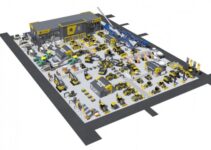The future of construction depends on emerging technologies — several of which are already transforming how construction projects are managed. These new technologies arise from other tech that has been around and evolving for decades. It’s no surprise that the ongoing digital transformation in construction is supported by data analytics, artificial intelligence (AI) and design technology innovations.
The evolving tech toolbox
People often use analytics and AI synonymously, but the terms are not interchangeable. AI creates human-like intelligence in machines and systems, whereas data analytics seek to create meaning from vast troves of data, allowing teams to make better and more informed decisions.
All analytics start out at the descriptive stage, and in the digital transformation of construction, descriptive analytics go hand in hand with any efforts to improve project outcomes. Take a look at field productivity, descriptive analytics could mine your data to spark questions you probably hadn’t even thought to ask.
For instance, what are the three most damaging things to productivity during task mobilization? When working on wall finishes, which step is causing an unusual escalation in time required? Answers to these questions and more not only inform day-to-day operations, but can also help when making schedules for other projects.
When predictions matter
Predictive analytics technology helps you predict outcomes based on past events. This is especially helpful for many aspects of modern construction projects including today’s complex supply chains.
The materials, tools and supplies used everyday on the jobsite originate across the globe. They are affected by economics, politics and resource availability. Wouldn’t it be helpful if you knew, as you bid for a job, that your main supplier of steel was seeing potential resource bottlenecks two months in the future? Moreover, how much more efficient could you be if you could predict the hour when your critical materials levels would run out?
In the future of construction technology, data analytics and AI could help manage your supply chain. The same technologies can even help integrate your project planning with your business planning so you can manage materials, tools and supplies across multiple projects.
Merging AI with data analytics
While they are not synonymous, the lines between AI and data analytics are blurring. Once you have data analytics showing the options for solving a problem, it is a short step to using an AI-enabled device or app to initiate the solution automatically.
This is already happening with automated earthwork machines and robotic machines that do tedious, repetitive work. Roles on the horizon for AI include more machines, systems and apps that completely automate construction processes, making human intervention the exception instead of the rule.
The larger advances in the future of construction will come from the combinations of technologies. Blending AI with analytics, sensors, digital twins, augmented reality, and robotics will create hybrid systems with the potential to free people for new innovative pursuits.
While new technology is making deep inroads during construction, other kinds of contech are starting to revolutionize the design and preconstruction phases.
Generative design: A vision for the future
Building information modeling (BIM) is well into its fifth generation and is getting even more valuable when working with two other technologies that are coming of age.
Generative design and design for manufacturing and assembly (DfMA), bring design intent to the forefront so building plans are complete right from the first day of mobilization.
Generative design empowers owners and designers with far-reaching vision. It helps them rapidly sort through many designs based on stated and measurable goals. This removes the starts and stops that often happen in the design process. Most importantly, for the construction phase, it removes the design options that are too far from the project’s stated goals. This eliminates uncertainty once the project is underway, meaning fewer change orders and much less rework.
Coupled with BIM, DfMa moves construction closer to a manufacturing state without sacrificing design options.
Historically, using manufacturing techniques for building meant limiting design options, but with DfMA, project components have fewer design constraints. With standardized connectors, any component, regardless of design, can connect to another.
This is going to accelerate prefabrication and modular approaches to construction. A recent Deloitte survey found that 46% of respondents plan to use prefabrication and modular construction in the coming year.
Both of these emerging construction technologies will help ensure the methods, materials and labor requirements are closely fit to the purpose. This will have a profound effect on safety, managing the materials portion of projects and mitigating the ongoing labor issues in the future of construction.
The digital transformation in construction has no shortage of technology to make it happen. Data analytics, AI and new approaches to design are leading the way.


